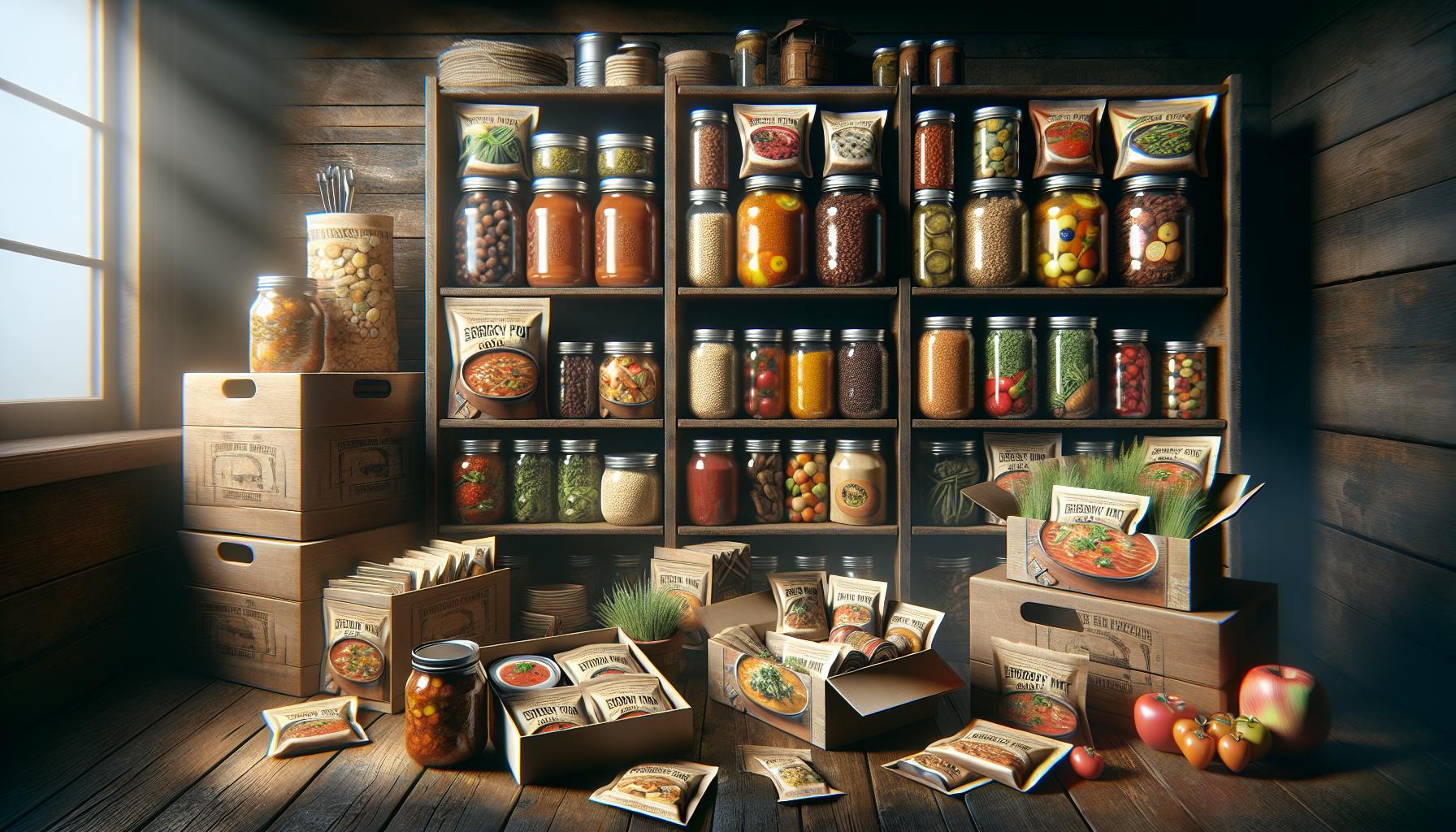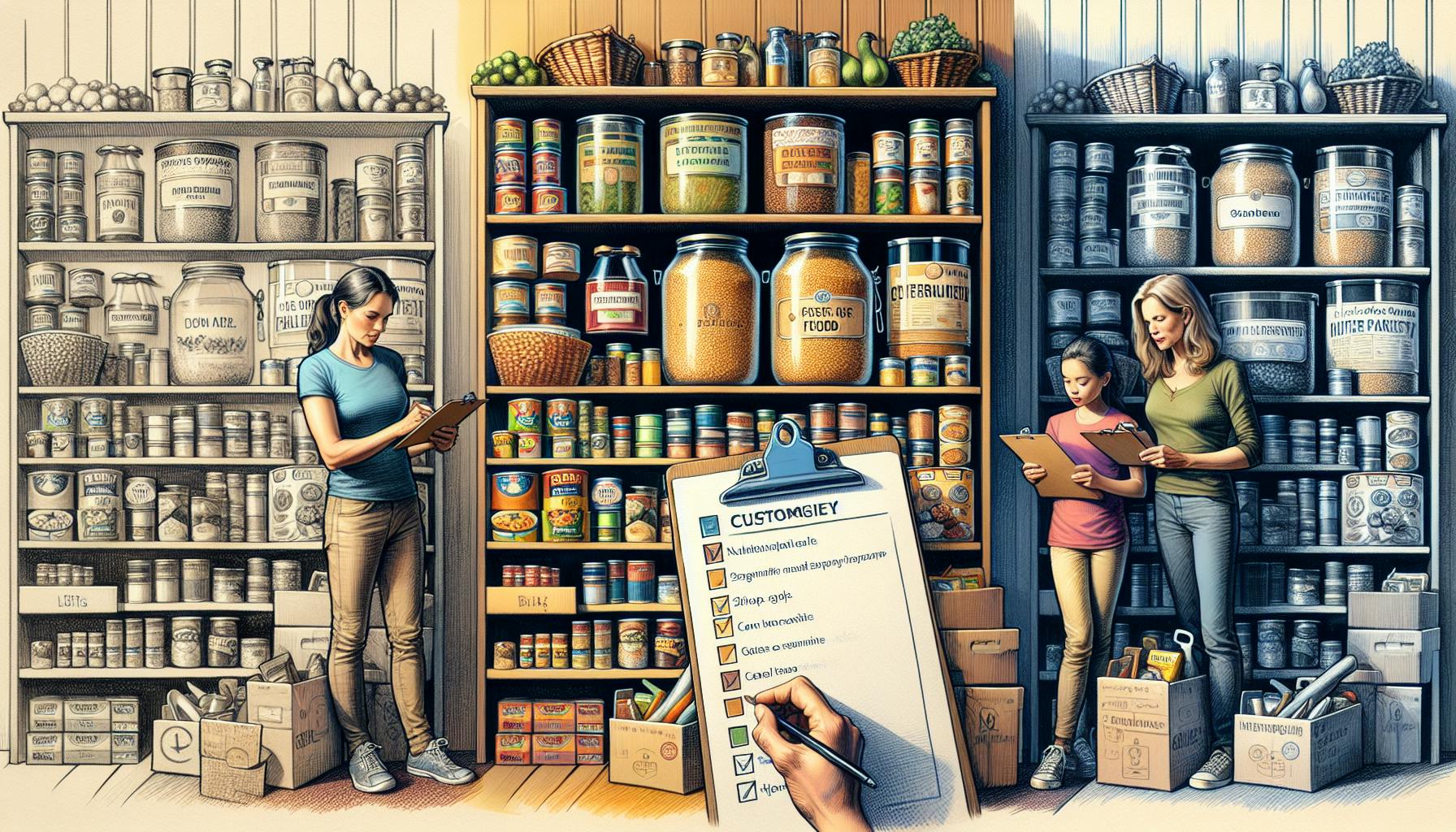Getting started with prepping can feel overwhelming for beginners when it comes to stocking your first prepper pantry.
This comprehensive guide outlines the essential items to include in a 30-day emergency food supply, providing a clear path for prepping newcomers.
You'll discover the staple foods that have long shelf lives, easy storage solutions to organize your prepper pantry, and tips to maintain your stockpile so it's ready when you need it.
Introduction to Prepping and Building Your First Prepper Pantry
This section provides an overview of prepping basics and considerations for building your first prepper pantry. As a newcomer, having the essential supplies on hand can help ensure you and your family are prepared in an emergency.
Understanding the Basics of Prepper Food Storage
When stockpiling food for an emergency prepper pantry, shelf life and storage conditions are key factors to consider. Focus on shelf-stable items that don't require refrigeration and have a longer expiration date. Properly stored white flour, white rice, dried beans, canned goods, nuts, and boxed cereal are good options. Check expiration dates and rotate your stock using the "first in, first out" method.
Essential Prepper Pantry Staples
Essential items for every prepper pantry include:
- Water - Have at least a 3-day supply of water for drinking and sanitation needs. Consider storing bottled water as well as several water filtration/purification options.
- Grains - Rice, pasta, oats, flour, etc. Opt for whole grains when possible.
- Canned/jarred goods - Canned fruits, vegetables, beans, soups, meats, broths. Go for low-sodium options when available.
- Proteins - Canned varieties like tuna, salmon, chicken, and beef. Also peanut butter, nuts, protein bars.
- Fats/Oils - Cooking oils like vegetable, olive, coconut. Also nuts, seeds, nut butters.
- Dried herbs, spices, bullion - For flavoring foods.
- Other - Honey, maple syrup, salt, vinegar, baking soda.
Setting Up Your Emergency Preparedness Kit
In addition to food, an emergency supply kit should contain:
- First aid supplies - Bandages, gauze, medicines, etc.
- Hygiene items - Toothbrush, toothpaste, soap, feminine products, etc.
- Tools - Manual can opener, multi-tool, duct tape, garbage bags.
- Light sources - Flashlight, lantern, candles, matches/lighter.
- Radio and extra batteries.
- Cash in small denominations.
Planning Your Emergency Fund and Emergency Plan
Having an emergency fund with enough savings to cover at least 3-6 months of expenses is advised. Also have a written emergency plan detailing evacuation routes, emergency contacts, meeting places, etc.
What foods should I stockpile for prepping?
When building your prepper pantry, focus on shelf-stable foods that provide protein, fruits and vegetables, grains, and of course - water. Here are some of the most essential items to include:
Canned and Dried Meats: Canned varieties of meat, chicken, turkey, tuna, salmon, and other proteins are nutritious additions that will last a long time. Opt for low-sodium versions when possible.
Canned Fruits and Vegetables: Keep a variety of canned produce like green beans, carrots, peas, peaches, pears, and pineapple. Choose options packed in juice rather than syrup.
Grains: Pasta, rice, oats, and quinoa are inexpensive prepper pantry basics. Look for whole grain varieties when possible.
Dried Beans: Beans are packed with fiber and plant-based protein. Stock up on dried pinto, black, kidney, garbanzo chickpeas, and lentils.
Water: Bottled water is essential for every prepper. Calculate to store at least 1 gallon per person per day. Consider adding water storage containers and water filtration methods as well.
Other Essentials: Don't forget oil, spices, honey, peanut butter, nuts, dried fruit, powdered milk, coffee, tea, vitamin supplements, and pet food.
When building your prepper pantry, focus on nutrient-dense non-perishable foods. Continually check expiration dates and rotate your stock to keep items fresh. With the right storage methods and emergency plan, you can keep your family fed in any situation.
What are the top 10 survival foods?
When building an emergency food supply, there are certain items that are essential to include. Here is a list of the top 10 survival foods that every prepper pantry should have:
- Peanut butter - A high-protein, high-fat food that is shelf-stable. Look for natural peanut butter without hydrogenated oils.
- Whole-wheat crackers - Provides carbohydrates and pairs perfectly with peanut butter for a balanced snack. Choose crackers with a long shelf life.
- Nuts and trail mixes - Great sources of protein, healthy fats, and nutrients. Prioritize nuts and mixes with less salt and sugar.
- Cereal or oatmeal - Choose whole grain cereals or quick oats that have a long shelf life. Avoid sugary cereals.
- Granola and protein bars - These portable bars are packed with nutrients and offer an easy breakfast or snack. Go for bars with wholesome ingredients.
- Dried fruits - Dried apricots, cranberries, raisins, etc. provide essential vitamins and antioxidants. Stock up on those without added sugars or preservatives.
- Canned fish - Canned tuna, salmon, sardines, etc. are excellent sources of protein. Opt for fish packed in water or olive oil rather than heavy oils.
- Canned vegetables - Non-perishable canned veggies like carrots, peas, beans, etc. provide key nutrients. Choose low-sodium or no salt added varieties.
- Canned soups and stews - Shelf-stable, ready-to-eat meals. Select options with lean protein, veggies, and whole grains for balanced nutrition.
- Honey - This natural sweetener has an indefinite shelf life. Honey offers antioxidants and soothing properties.
Focus on nutrient-dense non-perishables with a long shelf life. Store properly and check expiration dates to keep your emergency food fresh and safe for when you need it.
How do you stock a prepper pantry?
Stocking a well-prepared pantry starts with making a comprehensive list of essentials. When creating your prepper pantry, focus on nutrient-dense non-perishables with a long shelf life that don't require refrigeration.
Here is a starter checklist of must-have items:
- All-purpose flour, baking powder, baking soda - These baking essentials allow you to make bread, pancakes, etc. in an emergency. Opt for whole grain varieties when possible.
- Cooking oils - Choose healthy oils like olive, avocado or coconut oil in sturdy bottles. Oils should be stored properly to avoid rancidity.
- Bottled water - Having an emergency supply of water for drinking, cooking and hygiene is vital. Calculate based on your household needs.
- Rolled oats - A versatile whole grain that is packed with fiber and nutrients. Oats stay fresh for a long time when stored in airtight containers.
- Pasta and sauce - Dried pastas like spaghetti, penne or egg noodles are shelf-stable. Pair with canned pasta sauce for an easy meal. Seek low-sodium and organic options when available.
- Rice - White and brown rice are prepper pantry staples. They are affordable sources of calories and nutrients with a long shelf life. Use airtight containers and oxygen absorbers to prevent spoilage.
- Dried beans - Beans are packed with plant-based protein, fiber and nutrients. Stock up on versatile varieties like black, pinto, kidney and chickpeas. Rotate and use within 1 year.
When building your prepper pantry, focus on nutrient diversity and calories from whole food sources. Tailor your list to your household's unique needs and diet preferences. Properly store items to maximize freshness and shelf life.
sbb-itb-b932644
What do preppers stock up on?
When building your prepper pantry list, focus on non-perishable foods that don't require refrigeration and are relatively low in sodium. Some good options to stock up on include:
- Canned goods like beans, vegetables, fruits, soups, meats, and seafood. Opt for low-sodium varieties when possible.
- Whole grains like rice, quinoa, oats, and pasta
- Dried goods like beans, lentils, peas, nuts, trail mixes
- Comfort foods like granola bars, crackers, jerky
- Powdered milk, plant-based milk, or shelf-stable UHT milk
- Honey, maple syrup, olive oil, coconut oil
- Dried herbs and spices
In addition to food, make sure your emergency prep includes:
- Flashlights and lanterns
- Battery-powered or hand-crank radio
- Extra batteries
- Manual can opener
- Copies of important documents
- Basic first aid supplies
- Prescription medications
- Pet food if needed
Depending on your family's unique needs, you may also want to stock up on baby formula, diapers, feminine hygiene products, contact lens solution, or other specialty items. The key is tailoring your prepper food storage based on who's in your household.
When building your stockpile, pay attention to expiration dates, and don't have to refrigerate so they last longer in storage. Properly stored items like Properly stored flour and rice can last 30 years, while canned goods last 2-5 years typically.
Following basic food safety, like checking dates and keep foods fresh and safe during a power outage, ensures you have safe, nutritious foods when you need them most.
Creating Your First 30-Day Prepper Food Supply
This section provides tips and guidelines for stockpiling a 30-day supply of shelf-stable foods to feed your household in an emergency. Having these essentials on hand will ensure your family is prepared if stores close or supply chains are disrupted.
Grains, Cereals and Pasta: Properly Stored Flour and More
Storing whole grains and cereals can provide nutrients and carbohydrates. Prioritize shelf-stable options like rice, oats, pasta, quinoa, etc. Store in airtight containers and check expiration dates. Properly stored white or brown rice and pasta can last 30 years. Flour keeps 6-12 months if stored properly.
Tips for proper storage:
- Store in food-grade plastic or glass containers with tight lids
- Keep in cool, dark, and dry area like a pantry
- Check regularly for signs of spoilage
Canned and Jarred Foods: Nutrients Without Refrigeration
Stock up on canned or jarred fruits, vegetables, soups, meats and beans. Opt for low-sodium varieties with added nutrients when possible. Canned varieties can provide you with essential nutrients without refrigeration. Store in a cool, dark place and check expiration dates regularly.
Hydration Essentials: Drink Enough Water Every Day
Having an emergency supply of water is critical. Each person should drink at least a half gallon of water per day to stay healthy. Store commercially bottled water or use food-grade containers to create your own supply. Plan for at least one gallon per person, per day. Rotate stock to ensure freshness.
Printable Prepper Pantry List for a 30-Day Supply
Use this prepper pantry list as a reference when building your 30-day food supply:
View printable emergency food list (PDF)
Include a variety of grains, canned goods, snacks, and hydration items from the categories above. Check items for expiration dates as you purchase and organize. Update your stockpile over time, using and replacing items before they expire.
Expanding and Diversifying Your 3-6 Month Stockpile
Building on a 30-day supply, expanding your prepper pantry for long-term resilience requires careful consideration. Focus on nutrient-dense foods with a long shelf-life while also stocking essential non-food items.
Top 10 Prepper Foods for Long-Term Storage
When expanding your food stockpile, prioritize shelf-stable items that provide nutritional value. Useful options include:
- Canned goods like beans, vegetables, fruits packed in juice. Opt for low-sodium when possible.
- Whole grains like rice, quinoa, oats stored in airtight containers.
- Pasta, dried potatoes keep nearly indefinitely if stored properly.
- Honey - one of nature's superfoods that never spoils.
- Nuts, seeds, nut butters are calorie-dense. Store in cool area.
- Dried herbs and spices add flavor and nutrients.
- Powdered milk, eggs good for baking and cooking when fresh unavailable.
- Vegetable oils like olive and coconut oil store for months to years.
- Dried fruit provides fiber, vitamins and antioxidants.
- Protein powders offer protein from plant or dairy sources.
Rotate and eat oldest items first to avoid waste. Track expiration dates if applicable.
Creating and Storing an Emergency Water Supply
Having enough water during an extended crisis is critical. Guidelines recommend storing at least one gallon per person or pet per day. Consider:
- Bottled water - ideally store in cool, dark area. Replace every 6 months.
- Water storage containers - clean thoroughly first. Change water every 6 months.
- Water filtration/purification supplies - filters, chemical treatments, etc.
- Backup power for water well if applicable. Manual pumps as a contingency.
Ensure adequate water for drinking, food prep, hygiene. Monitor storage containers for leaks, odd smells or tastes.
Free Prepper Pantry List PDF: Comprehensive Stockpile Guide
For a detailed checklist covering a diverse 3-6 month supply, download our free Prepper Pantry List PDF. This comprehensive guide includes:
- Food items: 100+ shelf-stable goods plus quantities.
- Water storage - how much you need.
- First aid supplies
- Hygiene and sanitation items
- Key documents - copies and USB backups
- Communication tech - radio, batteries, chargers
- Lighting, tools, supplies for home/auto
- Pet food if applicable
Customize this list to your family size, needs and budget. Update as you build up emergency reserves.
Non-Food Essentials: Beyond the Food Stockpile Checklist
While food is critical, survival depends on more than just calories. Also stock:
- First aid kit - bandages, ointments, medicines, gloves, scissors, blanket.
- Sanitation and hygiene - toilet paper, feminine products, soap, toothpaste.
- Tools - knife, duct tape, tarps, rope, car kit, radio, flashlight, batteries.
- Paper products - plates, towels, toilet paper, paper towels.
- Clothing and bedding extras.
- Entertainment - books, games, playing cards.
Rotate stock as needed. Inspect equipment, test batteries every 6-12 months.
Key Tips for Organizing and Maintaining Your Prepper Pantry
This section provides important advice on taking inventory, tracking expiration dates, rotating stock, protective storage conditions etc. to keep your food stockpile fresh and usable over time.
Setting Up Storage Areas: Ways to Store Food in the Refrigerator
When setting up your prepper pantry, it's important to designate clean, cool, dark spaces for storage. Shelves, crates and bins can help neatly organize supplies. Make sure to maintain a safe refrigerator temperature between 35-40°F for perishables.
Here are some tips for organizing your refrigerator:
- Group similar items together on shelves
- Keep produce in high-humidity drawers
- Place milk, eggs, and other dairy in interior shelves
- Meat and poultry go on bottom shelves to prevent juices from dripping
Preventing Pests and Contamination
To avoid food spoilage and infestations, store items in airtight containers. Oxygen absorbers help remove oxygen from packaging to extend shelf life. Maintain cleanliness and inspect goods regularly for signs of bugs or mold.
Other tips include:
- Keep storage areas dry and cool
- Clean up spills immediately
- Take out garbage frequently
Inventory Management and Restocking
Use a spreadsheet to catalog all pantry items with purchase dates and expiration dates. Set reminders to use up short-dated stock first.
Build a replenishment system by:
- Making a master grocery list
- Planning weekly meals around ingredients on hand
- Restocking staples before they run out
Emergency Measures: Keep Foods Fresh and Safe During a Power Outage
To preserve perishables during an outage, limit opening the refrigerator and freezer. A full freezer will stay cold for 48 hours. Consider freezing water bottles to help keep food chilled.
When choosing a generator:
- Select a model with enough wattage for essential appliances
- Consider fuel type and availability
- Install a transfer switch to safely connect to household wiring
Following proper storage methods, monitoring conditions, and practicing inventory control will help ensure your prepper pantry stays fresh and ready for an emergency.
Final Tips and Next Steps for Prepping Beginners
Joining Local Prepping Networks
Connecting with like-minded preppers in your local area can provide community, support, and valuable resources as you continue your preparedness journey. Consider joining local prepper meetup groups, attending preparedness expos, or reaching out to neighbors who share similar interests in developing self-reliance skills. These networks can give you new ideas, share deals on prepper gear, and help motivate one another to stay vigilant in your prepping efforts.
Developing Key Skills
Beyond stocking your prepper pantry, focus on expanding your skillset through hands-on practice:
- Take first aid/CPR courses to handle medical emergencies
- Learn skills like foraging, hunting, fire-starting, and outdoor survival
- Practice ham radio operation for communication when cell networks are down
- Study ways to purify water, preserve food, and live off the grid
Books, videos, and in-person training on homesteading and self-sufficiency tactics will prepare you for longer-term crises.
Staying Vigilant Through Continued Education
Make continuing education a central part of your preparedness efforts:
- Keep up with current events both globally and locally that may impact your region
- Research emerging prepper tactics, technology, gear, and best practices
- Take new training courses annually on useful prepper skills
- Attend prepper expos and conferences to connect with experts
Remaining vigilant and proactive is key to rounding out your knowledge, skills, and resources.
Revisiting and Updating Your Prepper Pantry List Regularly
Get into the routine of revisiting your emergency food supply every 6 months. Take stock of what you have and make adjustments:
- Check all expiration dates and replace aging food items
- Look for gaps in nutrients or calories needed for your family
- Add innovative new prepper food options to your supply
- Take inventory and organize so you know exactly what's on hand
Keeping an up-to-date prepper pantry is crucial for ensuring you have what you need when an emergency strikes. Follow these tips to stay on top of it.


